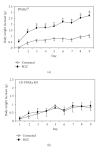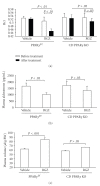Renal and vascular mechanisms of thiazolidinedione-induced fluid retention
- PMID: 18784848
- PMCID: PMC2531205
- DOI: 10.1155/2008/943614
Renal and vascular mechanisms of thiazolidinedione-induced fluid retention
Abstract
Thiazolidinediones (TZDs) are peroxisome proliferator-activated receptor subtype gamma (PPARgamma) activators that are clinically used as an insulin sensitizer for glycemic control in patients with type 2 diabetes. Additionally, TZDs exhibit novel anti-inflammatory, antioxidant, and antiproliferative properties, indicating therapeutic potential for a wide variety of diseases associated with diabetes and other conditions. The clinical applications of TZDs are limited by the common major side effect of fluid retention. A better understanding of the molecular mechanism of TZD-induced fluid retention is essential for the development of novel therapies with improved safety profiles. An important breakthrough in the field is the finding that the renal collecting duct is a major site for increased fluid reabsorption in response to rosiglitazone or pioglitazone. New evidence also indicates that increased vascular permeability in adipose tissues may contribute to edema formation and body weight gain. Future research should therefore be directed at achieving a better understanding of the detailed mechanisms of TZD-induced increases in renal sodium transport and in vascular permeability.
Figures



Similar articles
-
Thiazolidinediones and their fluid-related adverse effects: facts, fiction and putative management strategies.Drug Saf. 2007;30(9):741-53. doi: 10.2165/00002018-200730090-00002. Drug Saf. 2007. PMID: 17722967 Review.
-
Collecting duct-specific deletion of peroxisome proliferator-activated receptor gamma blocks thiazolidinedione-induced fluid retention.Proc Natl Acad Sci U S A. 2005 Jun 28;102(26):9406-11. doi: 10.1073/pnas.0501744102. Epub 2005 Jun 14. Proc Natl Acad Sci U S A. 2005. PMID: 15956187 Free PMC article.
-
Considerations for management of fluid dynamic issues associated with thiazolidinediones.Am J Med. 2003 Dec 8;115 Suppl 8A:111S-115S. doi: 10.1016/j.amjmed.2003.09.018. Am J Med. 2003. PMID: 14678876 Review.
-
PPARγ-induced stimulation of amiloride-sensitive sodium current in renal collecting duct principal cells is serum and insulin dependent.Cell Physiol Biochem. 2014;33(3):581-93. doi: 10.1159/000358636. Epub 2014 Feb 25. Cell Physiol Biochem. 2014. PMID: 24603133
-
Does Thiazolidinedione therapy exacerbate fluid retention in congestive heart failure?Pharmacol Ther. 2016 Dec;168:75-97. doi: 10.1016/j.pharmthera.2016.09.007. Epub 2016 Sep 4. Pharmacol Ther. 2016. PMID: 27598860 Review.
Cited by
-
MBX-102/JNJ39659100, a novel non-TZD selective partial PPAR-γ agonist lowers triglyceride independently of PPAR-α activation.PPAR Res. 2009;2009:706852. doi: 10.1155/2009/706852. Epub 2009 Apr 23. PPAR Res. 2009. PMID: 19404482 Free PMC article.
-
Rosiglitazone Suppresses Calcium Oxalate Crystal Binding and Oxalate-Induced Oxidative Stress in Renal Epithelial Cells by Promoting PPAR-γ Activation and Subsequent Regulation of TGF-β1 and HGF Expression.Oxid Med Cell Longev. 2019 Nov 12;2019:4826525. doi: 10.1155/2019/4826525. eCollection 2019. Oxid Med Cell Longev. 2019. PMID: 31781338 Free PMC article.
-
Efficacy and tolerability of pioglitazone in patients with type 2 diabetes mellitus: comparison with other oral antihyperglycaemic agents.Drugs. 2010 Oct 22;70(15):1945-61. doi: 10.2165/11538100-000000000-00000. Drugs. 2010. PMID: 20883052 Review.
-
Pioglitazone in the treatment of type 2 diabetes: safety and efficacy review.Clin Med Insights Endocrinol Diabetes. 2010;3:43-51. doi: 10.4137/cmed.s5372. Epub 2010 Aug 3. Clin Med Insights Endocrinol Diabetes. 2010. PMID: 22879786 Free PMC article.
-
Soluble epoxide hydrolase inhibition and peroxisome proliferator activated receptor γ agonist improve vascular function and decrease renal injury in hypertensive obese rats.Exp Biol Med (Maywood). 2012 Dec;237(12):1402-12. doi: 10.1258/ebm.2012.012225. Exp Biol Med (Maywood). 2012. PMID: 23354399 Free PMC article.
References
-
- Füchtenbusch M, Standl E, Schatz H. Clinical efficacy of new thiazolidinediones and glinides in the treatment of type 2 diabetes mellitus. Experimental and Clinical Endocrinology & Diabetes. 2000;108(3):151–163. - PubMed
-
- Hirsch IB, Kelly J, Cooper S. Pulmonary edema associated with troglitazone therapy. Archives of Internal Medicine. 1999;159(15):p. 1811. - PubMed
-
- Thomas ML, Lloyd SJ. Pulmonary edema associated with rosiglitazone and troglitazone. The Annals of Pharmacotherapy. 2001;35(1):123–124. - PubMed
-
- (Pioglitazone) PIA. Takeda Pharmaceuticals, Inc.
-
- (Rosiglitazone) PIA. GlaxoSmithKline Pharmaceuticals.
Grants and funding
LinkOut - more resources
Full Text Sources
Other Literature Sources

